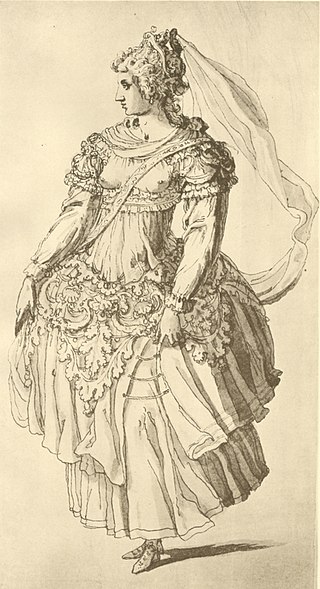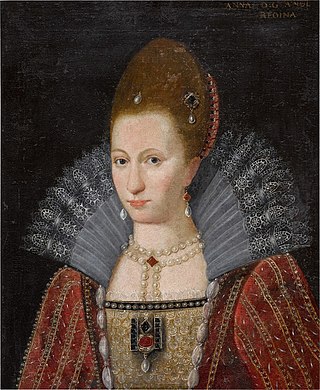Christopher Shawe or Shaw (died 1618) was an English embroiderer and textile artist who worked on masque costume for Anne of Denmark. He was a member of the Worshipful Company of Broderers.
Contents

Christopher Shawe or Shaw (died 1618) was an English embroiderer and textile artist who worked on masque costume for Anne of Denmark. He was a member of the Worshipful Company of Broderers.

In September 1589, Shawe married Isobel Buttes, originally from Streatham, at St Benet's, Paul's Wharf, the church used by the College of Arms. [1]
Shawe worked on masque costume in December 1603 for the female dancers in The Vision of the Twelve Goddesses , and presumably other masques of the season. Some of the costume was recycled from the wardrobe of Elizabeth I. He also worked on other "parcels" (orders) of embroidery for Anne of Denmark supplied to Audrey Walsingham. [2]
"Master Shawe" was paid £106-7s for work on costumes for The Masque of Beauty in January 1608. [3] He worked on costumes for the masque Tethys' Festival in 1610 and his bill detailing his work survives. [4] He embroidered cobweb silver lawn with veins of silver and sea green silk, sewed motifs with silver and gold oes, [5] and embroidered a pair of sea green satin dancing shoes. [6] At least one of the costumes he worked on features in an inventory of Anne of Denmark's wardrobe. [7]
His bill of 5 June 1610 included:
Item, for inbrathring vij [7] yards of Copwede lane [cobweb lane] withe vaines of scilver and segrene and scilver oose and Carn[a]tion scilke, for working scilver and scilke vij. li [£7]
Item, for inbrawthering xxviij yards of tiffenne vere riche with oose goold, for working, scilke and goold oose xviij. li. [£18]
Item, for inbrawthering a peare of shues of segrene satten [sea green satin] vere riche, for workeng, goold and scilke iij. li. [£3] [8]
The costume and shoes were for Anne of Denmark herself, who played the Titan sea goddess Tethys with her ladies as rivers personified. [9] A drawing by Inigo Jones of a costume for Tethys or a nymph with "shoes of satin, richly imbrodered" survives. [10]
The seven yards of embroidered cobweb lawn were probably for the queen's veil. Cobweb lawn and net lawn were fine linens suitable for veils. [11] Male performers in Jonson's Masque of Hymen wore crowns with veils of carnation and silver net lawn. [12] Anne of Denmark owned a number of mantles, made of the lightweight fabrics tiffany, tinsel, and cobweb lawn. [13]
During the masque Tethys gave Prince Henry an embroidered scarf, figuratively or literally representing Britain, a "zone of love and amity". It is not clear if Shawe embroidered this prop, and some 19th-century writers including Agnes Strickland, Charlotte Mary Yonge, and Robert Folkestone Williams assumed that Anne of Denmark had made it herself. [14]
Shawe was not paid in full and petitioned for payment for work on the masque and other embroidery for the queen. [15]
Shawe died on 31 July 1618 and was buried at St Margaret's Chipstead, where an inscription records him as a Citizen of London and "Imbrodorer". [16]
The names of other court embroiderers of this period are known, including James Freeland, the queen's embroiderer, Edmund Palmer, described as embroiderer to the queen and Prince Henry, and John Parr (died 1607), John Shepley, and William Broderick (died 1620), were embroiderers to King James. They employed numbers of workmen. Ribbons and passementerie were provided by silkmen, including Benjamin Henshawe. [17]
By his will of 5 October 1617 he bequeathed an annuity of 20 shillings from his Chipstead property, Sturrock Crofts, and his tenement in London, the Barge in St Benets, administered by the London Embroiderer's Company, to be given in bread to the poor of the parish of Chipstead, and £3 to the schoolmaster at Market Harborough. He left 20 shillings yearly for the churchwardens of St Benets to give to the poor on 5 November in memory of the discovery of the Gunpowder Plot. [18]
He had two daughters and three sons, including Christopher Shawe, younger, who worked with him as an embroiderer for Anne of Denmark and had a house in St Benets at "Audlyn Hill", now Addle Hill. [19] The king's embroiderer William Brotherick lived next door, conveniently sited for the royal Great Wardrobe. The younger Shawe's widow and executrix, Margaret Shawe, petitioned William Juxon and other officials for payment of £439-12s after his death. She mentioned that she had three young children at the time of Christopher Shawe's death. The petitions refer to him as Christopher Shawe, younger, servant of Anne of Denmark. [20] While adjudicating a similar petition, Juxon consulted Zachary Bethell's account book of "Queen Anne's Robes". [21]

Anne of Denmark was the wife of King James VI and I. She was Queen of Scotland from their marriage on 20 August 1589 and Queen of England and Ireland from the union of the Scottish and English crowns on 24 March 1603 until her death in 1619.

George Home, 1st Earl of Dunbar, KG, PC was, in the last decade of his life, the most prominent and most influential Scotsman in England. His work lay in the King's Household and in the control of the State Affairs of Scotland and he was the King's chief Scottish advisor. With the full backing and trust of King James he travelled regularly from London to Edinburgh via Berwick-upon-Tweed.

Elizabeth Grey, Countess of Kent was a medical recipe collector, and the wife of Henry Grey, 8th Earl of Kent.
The Masque of Beauty was a courtly masque written by Ben Jonson, and performed in London's Whitehall Palace on 10 January 1608. It inaugurated the refurbished banquesting hall of the palace. It was a sequel to the preceding Masque of Blackness, which had been performed three years earlier, on 6 January 1605. In The Masque of Beauty, the "daughters of Niger" of the earlier piece were shown cleansed of the black pigment they had worn on the prior occasion.

The Vision of the Twelve Goddesses was an early Jacobean-era masque, written by Samuel Daniel and performed in the Great Hall of Hampton Court Palace on the evening of Sunday, 8 January 1604. One of the earliest of the Stuart Court masques, staged when the new dynasty had been in power less than a year and was closely engaged in peace negotiations with Spain, The Vision of the Twelve Goddesses stood as a precedent and a pattern for the many masques that followed during the next four decades.
Jean Ker, Countess of Roxburghe, néeDrummond (c.1585–1643) was a Scottish courtier, serving Anne of Denmark in Scotland and England.

Susan Herbert, Countess of Montgomery, was an English court office holder. She served as lady-in-waiting to the queen consort of England and Scotland, Anne of Denmark. She was the youngest daughter of Elizabethan courtier, and poet Edward de Vere, 17th Earl of Oxford.
Lady Audrey Walsingham was an English courtier. She served as Lady of the Bedchamber to queen Elizabeth I of England, and then as Mistress of the Robes to Anne of Denmark from 1603 until 1619.

Tethys' Festival was a masque produced on 5 June 1610 to celebrate the investiture of Prince Henry (1594–1612) as Prince of Wales.
Bridget Annesley was a courtier to Anne of Denmark, wife of James VI and I.
Mary Gargrave was a courtier to Anne of Denmark.
Dorothy Speckard or Speckart or Spekarde was a courtier, milliner, silkwoman, and worker in the wardrobe of Elizabeth I of England, Anne of Denmark, Prince Henry, and Henrietta Maria. Her husband, Abraham Speckard, was an investor in the Somers Isles Company which colonised Bermuda.

Jemma Field is a historian and art historian from New Zealand. She studied for her PhD with Erin Griffey at the University of Auckland. She was subsequently a Marie Skłodowska-Curie postdoctoral fellow at Brunel University, London. She is currently Associate Director of Research at the Yale Center for British Art.
Thomas Capp or Cappe was a London-based painter and gilder.
Thomazine or Thomasine Carew was an English courtier.

The jewels of Anne of Denmark (1574–1619), wife of James VI and I and queen consort of Scotland and England, are known from accounts and inventories, and their depiction in portraits by artists including Paul van Somer. A few pieces survive. Some modern historians prefer the name "Anna" to "Anne", following the spelling of numerous examples of her signature.

The wedding of Elizabeth Stuart (1596–1662), daughter of James VI and I, and Frederick V of the Palatinate (1596–1632) was celebrated in London in February 1613. There were fireworks, masques, tournaments, and a mock-sea battle or naumachia. Preparations involved the construction of a "Marriage room", a hall adjacent to the 1607 Banqueting House at Whitehall Palace. The events were described in various contemporary pamphlets and letters.

Peter Rannald was a Scottish tailor who worked for Anne of Denmark, the wife of James VI of Scotland.
Zachary Bethell was an English courtier, an usher, and administrator in the wardrobes of Anne of Denmark and Henrietta Maria.

Oes or owes were metallic O-shaped rings or eyelets sewn on to clothes and furnishing textiles for decorative effect. They were used on various clothing and furnishing fabrics and were smaller than modern sequins. Made of gold, silver, or copper, oes were made either from rings of wire or out of a sheet of metal.